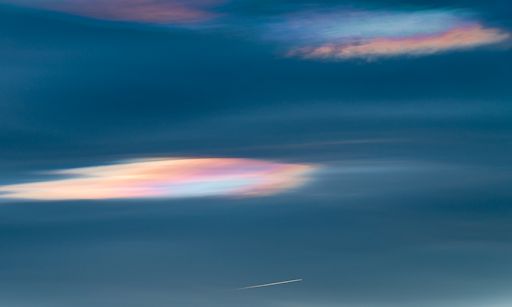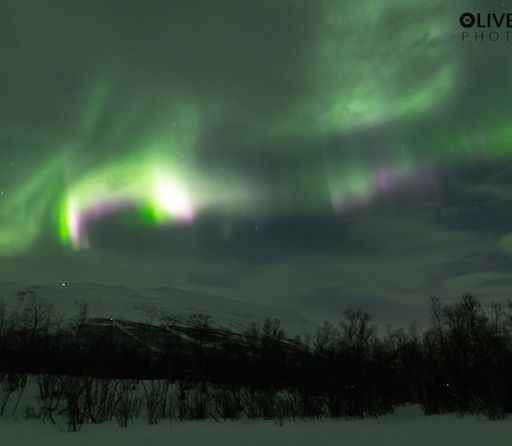Marianne's Heaven On Earth Aurora Chaser Tours Chasethelighttours.co.uk invites you to join them in their quest to find and photograph the Aurora Borealis. Experience the winter wonderland in the Tromsø Area. | | | QUIET SUN: With no sunspots actively flaring, the sun's X-ray output has flatlined. The quiet is likely to continue for at least the next 24 hours. NOAA forecasters say there is no more than a 1% chance of strong flares on Feb.1st. Solar flare alerts: text or voice COLORFUL CLOUDS IN THE STRATOSPHERE: The stratosphere of our planet is not a cloudy place. More than 80,000 feet above Earth's surface, the thin air tends to be very clear. Nevertheless, sometimes clouds do form in the stratosphere, and when they do, they are fantastically colorful. Øistein Hansen saw these polar stratospheric clouds (PSCs) on Jan. 31st over Eidsvoll, Akershus, Norway: 
Also known as "nacreous" or "mother of pearl" clouds, icy PSCs form in the lower stratosphere when temperatures drop to around minus 85ºC. High-altitude sunlight shining through tiny ice particles ~10µm wide produce bright iridescent colors by diffraction and interference. "Nacreous clouds far outshine and have much more vivid colours than ordinary iridescent clouds, which are very much poor relations and seen frequently all over the world," says atmospheric optics expert Les Cowley. "Once seen they are never forgotten." These clouds are rare, yet they have been frequently sighted in the past few days. A "stratospheric cloud event" is underway with reports of the colorful puffs coming from places as far south as the UK. High-latitude sky watchers should be alert for PSCs. The best time to see them is just before sunrise or after sunset. Realtime Stratospheric Cloud Photo Gallery UNEXPECTED AURORAS SHINE THROUGH CLOUDS: Solar activity is very low. Nevertheless, sky watchers around the Arctic Circle are reporting Northern Lights. "I just saw the brightest and fastest-moving aurora I've seen in the past 4 years," says Oliver Wright of Abisko, Sweden. The auroras were so intense, they could be seen through heavy clouds: 
"With solar activity so low, what triggered this amazing display?" asks Wright. Answer: The interplanetary magnetic field (IMF) near Earth has tipped south, opening a crack in Earth's magnetosphere. Solar wind is pouring in to fuel the display. Arctic sky watchers should remain alert for more auroras on Feb. 1st. Aurora alerts: text or voice Realtime Aurora Photo Gallery
Realtime Spaceweather Photo Gallery
Realtime Comet Photo Gallery Every night, a network of NASA all-sky cameras scans the skies above the United States for meteoritic fireballs. Automated software maintained by NASA's Meteoroid Environment Office calculates their orbits, velocity, penetration depth in Earth's atmosphere and many other characteristics. Daily results are presented here on Spaceweather.com. On Feb. 1, 2016, the network reported 1 fireballs.
(1 sporadic)  In this diagram of the inner solar system, all of the fireball orbits intersect at a single point--Earth. The orbits are color-coded by velocity, from slow (red) to fast (blue). [Larger image] [movies] Potentially Hazardous Asteroids ( PHAs) are space rocks larger than approximately 100m that can come closer to Earth than 0.05 AU. None of the known PHAs is on a collision course with our planet, although astronomers are finding new ones all the time. On February 1, 2016 there were potentially hazardous asteroids. Notes: LD means "Lunar Distance." 1 LD = 384,401 km, the distance between Earth and the Moon. 1 LD also equals 0.00256 AU. MAG is the visual magnitude of the asteroid on the date of closest approach. | | Cosmic Rays in the Atmosphere | | Situation Report -- Oct. 30, 2015 | Stratospheric Radiation (+37o N) | | Cosmic ray levels are elevated (+6.1% above the Space Age median). The trend is flat. Cosmic ray levels have increased +0% in the past month. | | Sept. 06: 4.14 uSv/hr (414 uRad/hr) | | Sept. 12: 4.09 uSv/hr (409 uRad/hr) | | Sept. 23: 4.12 uSv/hr (412 uRad/hr) | | Sept. 25: 4.16 uSv/hr (416 uRad/hr) | | Sept. 27: 4.13 uSv/hr (413 uRad/hr) | | Oct. 11: 4.02 uSv/hr (402 uRad/hr) | | Oct. 22: 4.11 uSv/hr (411 uRad/hr) | These measurements are based on regular space weather balloon flights: learn more. Approximately once a week, Spaceweather.com and the students of Earth to Sky Calculus fly "space weather balloons" to the stratosphere over California. These balloons are equipped with radiation sensors that detect cosmic rays, a surprisingly "down to Earth" form of space weather. Cosmic rays can seed clouds, trigger lightning, and penetrate commercial airplanes. Our measurements show that someone flying back and forth across the continental USA, just once, can absorb as much ionizing radiation as 2 to 5 dental X-rays. For example, here is the data from a flight on Oct. 22, 2015: 
Radiation levels peak at the entrance to the stratosphere in a broad region called the "Pfotzer Maximum." This peak is named after physicist George Pfotzer who discovered it using balloons and Geiger tubes in the 1930s. Radiation levels there are more than 80x sea level. Note that the bottom of the Pfotzer Maximim is near 55,000 ft. This means that some high-flying aircraft are not far from the zone of maximum radiation. Indeed, according to the Oct 22th measurements, a plane flying at 45,000 feet is exposed to 2.79 uSv/hr. At that rate, a passenger would absorb about one dental X-ray's worth of radiation in about 5 hours. The radiation sensors onboard our helium balloons detect X-rays and gamma-rays in the energy range 10 keV to 20 MeV. These energies span the range of medical X-ray machines and airport security scanners. | | The official U.S. government space weather bureau | | | The first place to look for information about sundogs, pillars, rainbows and related phenomena. | | | Researchers call it a "Hubble for the sun." SDO is the most advanced solar observatory ever. | | | 3D views of the sun from NASA's Solar and Terrestrial Relations Observatory | | | Realtime and archival images of the Sun from SOHO. | | | from the NOAA Space Environment Center | | | the underlying science of space weather | | | Web-based high school science course with free enrollment | | 
